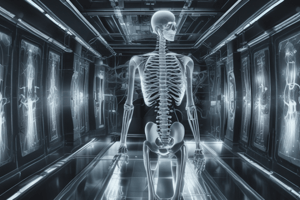Podcast
Questions and Answers
What does foreshortening in an X-ray image result from?
What does foreshortening in an X-ray image result from?
- Excessive vertical angle of the X-ray beam (correct)
- Improper alignment of the X-ray beam to the film
- Insufficient vertical angulation of the X-ray beam
- Improper positioning of the object relative to the detector
Which factor contributes to elongation of an X-ray image?
Which factor contributes to elongation of an X-ray image?
- X-ray source positioned too close to the object
- X-ray beam not angled sufficiently (correct)
- Beam divergence from the X-ray source
- Too much distance between the beam and the detector
What is the primary cause of distortion in X-ray images?
What is the primary cause of distortion in X-ray images?
- X-ray beam not being perpendicular to the tooth and film (correct)
- Poor vertical angulation of the X-ray beam
- Excessive distance between the object and the detector
- Minimized distance between the source and object
What position is ideal for minimizing an object's magnification in X-ray imaging?
What position is ideal for minimizing an object's magnification in X-ray imaging?
Which statement correctly describes the relationship between source-to-object distance and image distortion?
Which statement correctly describes the relationship between source-to-object distance and image distortion?
What is the main effect of beam divergence in X-ray imaging?
What is the main effect of beam divergence in X-ray imaging?
When aiming for geometrically accurate X-ray images, what should be avoided?
When aiming for geometrically accurate X-ray images, what should be avoided?
What is a significant consideration when positioning the object for X-ray imaging?
What is a significant consideration when positioning the object for X-ray imaging?
Flashcards
X-ray Image Distortion
X-ray Image Distortion
A misrepresentation of an object's shape in an X-ray image due to improper alignment of the X-ray beam, the object, or the detector.
Foreshortening
Foreshortening
An X-ray image artifact where an object appears shorter than its actual size due to improper vertical angulation of the X-ray beam and source being too close to the object.
Elongation
Elongation
An X-ray image artifact where an object appears longer than its true size due to insufficient vertical angulation of the x-ray beam and source being too far from the object.
Parallel X-ray Beams
Parallel X-ray Beams
Signup and view all the flashcards
Object to Detector Distance
Object to Detector Distance
Signup and view all the flashcards
Source to Object Distance
Source to Object Distance
Signup and view all the flashcards
Beam Divergence
Beam Divergence
Signup and view all the flashcards
Image Receptor
Image Receptor
Signup and view all the flashcards
Study Notes
X-Ray Image Accuracy
- To create accurate X-ray images, the object should be as close as possible to the detector and the beams should be parallel.
- This minimizes distortion.
Image Distortion Causes
-
Foreshortening: Occurs when the X-ray beam is angled too steeply relative to the tooth and film. This makes the image appear shorter than the actual object. This happens when the X-ray source is too close to the object in the vertical plane.
-
Elongation: Occurs when the X-ray beam is not angled steeply enough. The image appears longer than the actual object. Insufficient vertical angulation causes the X-ray source to be too far from the object in the vertical plane.
-
Distortion: Results from the X-ray beam not being properly aligned perpendicular to the tooth and film. This distorts the image, potentially shortening some parts and elongating others, leading to an inaccurate representation of the object's shape.
Minimizing Distortion
- The object should be as close as possible to the image receptor to minimize magnification and maximize sharpness.
- The source to object distance should be maximized to ensure parallel X-ray beams, which reduce distortion.
- The X-ray source should be as far from the detector as possible, while maintaining parallel beams.
- The object should be as close to the detector as possible to reduce the effect of beam divergence.
Studying That Suits You
Use AI to generate personalized quizzes and flashcards to suit your learning preferences.
Description
Explore the key concepts of X-ray image accuracy, including the effects of foreshortening, elongation, and overall image distortion. This quiz will help you understand the best practices for ensuring accurate X-ray representations. Learn how to minimize distortion for better diagnosis and analysis.




